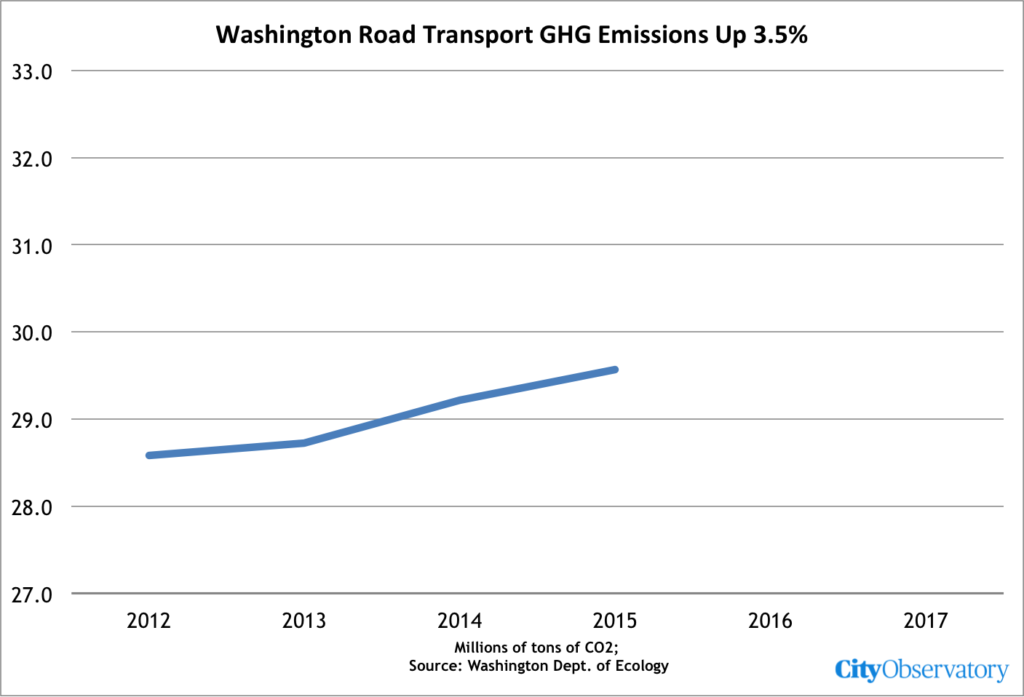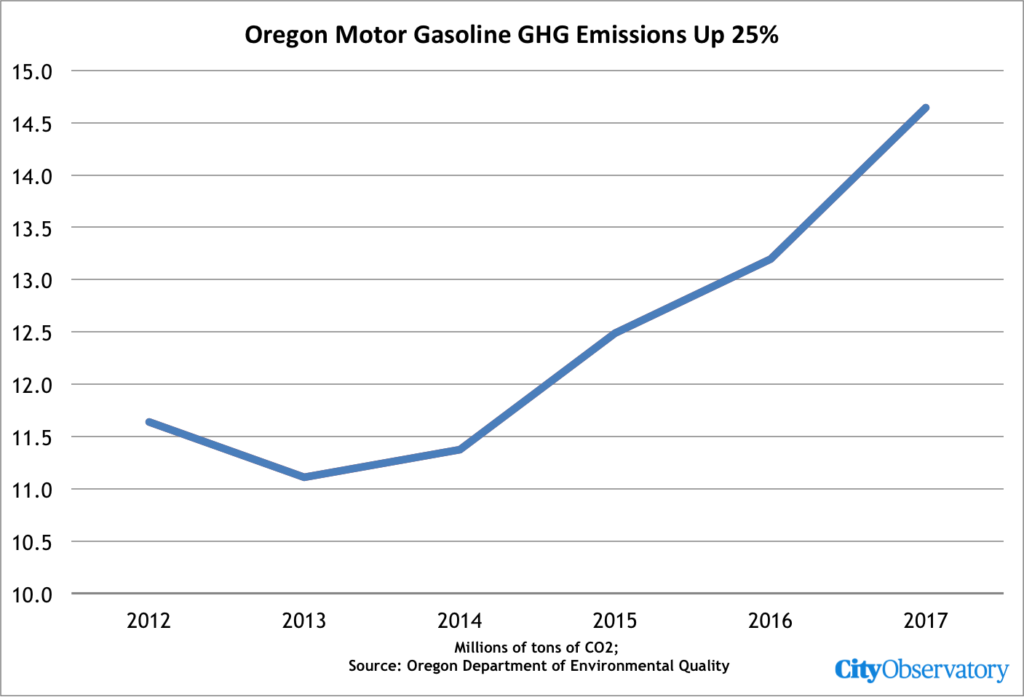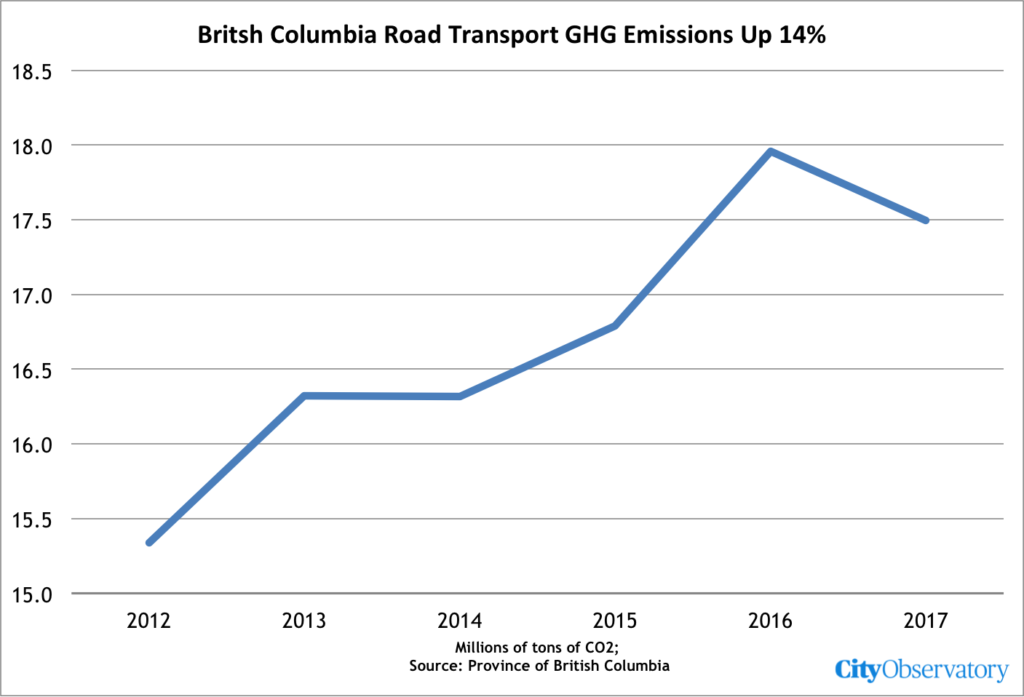West Coast political leaders talk a good greenhouse gas game, but actions speak louder
Throughout Ecotopia, carbon emissions are rising due to more driving, yet the region’s leaders are throwing even more money at subsidizing car travel
This weekend, leaders of some of the world’s most environmentally progressive cities are meeting in Copenhagen for the C40 World Mayors Summit. They’re both calling attention to the gravity of the climate crisis and also celebrating the steps that cities have taken to reduce greenhouse gas emissions. One of the Summit’s key talking points is that 30 cities world wide have passed “peak carbon emissions”–an impressive sounding phrase that simply means that today they emit at least somewhat less carbon than they did five or more years ago. Several West Coast Mayors are prominent in the event: Seattle’s Jenny Durkan is speaking there, Portland’s Ted Wheeler is in attendance. Los Angeles Mayor Eric Garcetti is the newly anointed head of the Summit organization, succeeding Paris Mayor Anne Hidalgo.
Since these mayors are presenting themselves, and their cities as leaders, we though it would be useful to take a look at how the region they represent is doing. So, you might ask: How are things in Ecotopia?
In 1975, Ernest Callenbach created a fable about environmentalists on the West Coast breaking away from the rest of North America to found a separatist new-age state called Ecotopia. Stretching roughly from San Francisco to British Columbia, this would be a utopian land governed by enlightened green leaders, powered by renewable energy.

By comparison to the rest of the continent, governments in California, Oregon, Washington and British Columbia have all been environmentally progressive. The three states have adopted greenhouse gas reduction goals; BC has a carbon tax. The region has considerable investments in renewable energy like hydropower and wind. Their leaders all pay fealty to the importance of adhering to the Paris Climate Accords (even when repudiated by national governments). But in each of these states, performance falls well short of rhetoric, especially when it comes to transportation-related carbon emissions, which are the biggest source of greenhouse gases in each of the three Pacific Coast states.
Washington: More carbon emissions and a freeway-building spree
Most prominently, Washington Governor Jay Inslee built the platform for his now-folded Presidential campaign squarely on the issue of climate change. He prodded his opponents to discuss climate and arguably played a key role in pushing one town hall debate to focus almost solely on that subject. That was certainly long overdue.
But back at the ranch, Inslee’s environmental record falls well short of his Greta Thunberg rhetoric. Washington is fully embarked on a decade-long multi-billion dollar freeway widening spree, financed by taxes enacted during Inslee’s tenure. The plan dedicates nearly 10 billion dollars to new or widened freeways, and less than a fifth that amount to road maintenance.
And this comes at a time when Washington, like other states, is recording an increase in greenhouse gas emissions, chiefly due to increased driving. Greenhouse gas emissions in Washington are up 6 percent since 2013, and emissions from on-road vehicles have increased by more than 1 million tons during that time, according to the State’s latest greenhouse gas emissions inventory. (While the City of Seattle gets appropriate credit for allowing greater density, investing in transit expansion, and netting an increase in bus ridership, things outside the central city are much less green.)
Oregon: More Carbon emissions and a freeway-building spree
Like Washington, Oregon has a greenhouse gas emissions inventory, and it shows the same trend: statewide carbon emissions are up 6.6 percent since 2012, chiefly due to the increase in driving statewide. The City of Portland’s own greenhouse audit is just as bad: increased driving has led transportation emissions to increase 14 percent since 2012. The failure to make progress in greenhouse gas reduction has everything to do with more driving as gas prices have declined. Since 2012, Oregon’s statewide emissions from motor vehicle gasoline have increased an astonishing 25 percent according to figures from the Oregon Department of Environmental Quality–from 11.64 million tons in 2012 to 14.64 million tons in 2017.
Despite the failure at the state and city level to meet greenhouse gas reduction goals, Oregon is plowing ahead with a multi-billion dollar program to widen Portland area freeways, which will undoubtedly lead to more driving and higher carbon emissions in the future.
Portland Mayor Ted Wheeler and Governor Kate Brown talk a good game on climate, but both have done nothing to challenge pollution inducing freeway projects, noticeably the $500 million Rose Quarter Freeway widening in Portland. The gap between rhetoric and reality on climate change in Oregon is growing ever wider.
British Columbia: More carbon emissions and abolishing bridge tolls
British Columbia’s carbon emissions inventory shows the same patterns as its Southern neighbors. Greenhouse gas emissions from road transport have risen 14 percent in the past five years according to the provincial report.
Even thought the Green Party is part of the the Province’s ruling coalition, the provincial government abolished tolls on a pair of expensive Vancouver area bridges–effectively shifting the cost of car travel off to all of the non-users of the bridges, including car-free households. It’s exactly the kind of strategy that’s likely to lead to increased vehicle travel and more sprawling development in the Lower Mainland suburbs around Vancouver.
California: Cap and Trade, but 30 years behind schedule
California, to its credit, has adopted a cap-and-trade policy, making it a leader in carbon pricing. But it too is falling behind in its efforts to reduce carbon emissions. The state’s latest greenhouse gas report says that carbon emissions are up five percent in the past five years. Transportation is far and away the largest source of greenhouse gases in the Golden State.
Like its neighbors, California continues to plow more money into freeway expansions. It famously spent more than a billion dollars to widen a stretch of the 405 freeway in Los Angeles, only to find that it simply attracted more traffic and ended up just as congested as ever–and with higher levels of carbon emissions. Despite progress in some areas, the state is lagging well behind the pace of improvement needed to meet it’s stated greenhouse gas reduction goals; a new report estimates that it will hit its 2030 goal in 2060, meaning that the state is about three-decades behind where it needs to be.
Pro-Tip: Don’t blame the economic recovery; It’s all about cheap gas
One of the favorite excuses offered for this consistently bad performance in transportation greenhouse gas emissions is to attribute the growth in carbon emissions to a growing economy. But blaming the economy is simply wrong: Notice that in almost every case the robust growth in transportation emissions comes only after 2014 (Washington’s data goes only through 2015). By 2014, the economic recovery was already in its fourth year; what happened that year is that oil prices plunged about 40 percent globally, pushing down retail gas prices by a similar amount. Cheaper gas led to more driving (and higher sales of less fuel-efficient, higher polluting vehicles).
Whither Ecotopia?
If you were putting your faith in Ecotopia to lead the way, and especially if you’ve been beguiled by the tough-talking climate rhetoric of the region’s political leaders, what’s happening on the ground, and particularly in the form of investments in more subsidized car infrastructure, should give you pause. Despite the hype, this green region has a long way to go to be a real role model for saving the planet.
What’s needed, if we’re serious about reducing greenhouse gas emissions, are measures that reflect back to transport users the real environmental costs of carbon emissions. By any measure, road use is heavily subsidized, and coupled with under-priced gasoline, is undercutting incentives to drive less and pollute less. Real ecotopians would harness the power of the price mechanism, through the form of a carbon tax, value-pricing of roads, and an end to subsidized parking. We’ll be watching to see if they write a next chapter that is more convincing than the last one.





